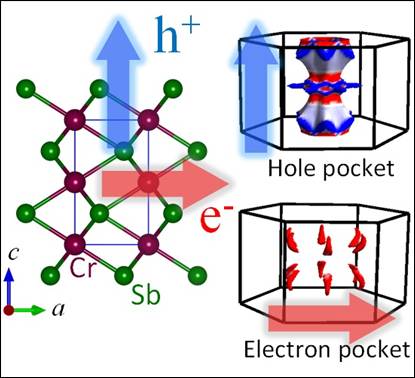Context:
Scientists at the S N Bose National Centre for Basic Sciences (SNBNCBS), an autonomous institution under India’s Department of Science and Technology, have recently uncovered a remarkable property of high-quality single-crystalline chromium antimonide (CrSb). They observed a direction-dependent conduction polarity (DDCP)—a phenomenon extremely rare in solid materials.
About the discovery:
The team at SNBNCBS found that CrSb changes its conduction behavior based on current direction:
- When electric current flows within the layers of the crystal (like moving along the pages of a book), conduction is through electrons (n-type behavior).
- When current flows across the layers (like flipping through the pages), conduction happens through holes (p-type behavior).
This dual conduction property within a single material is not just rare—it is the first time such behavior has been reported in any altermagnet.
This discovery is important because it challenges the traditional classification of materials as either p-type (conducting through positively charged holes) or n-type (conducting through negatively charged electrons). In most cases, a single material shows only one type of conduction. However, CrSb can exhibit both, depending on the direction in which electric current flows.
About Altermagnets and CrSb
CrSb belongs to a newly discovered class of magnetic materials called altermagnets. Unlike common ferromagnets, which show strong external magnetism (like ordinary magnets), or antiferromagnets, whose internal magnetism cancels out completely, altermagnets display hidden magnetic order without any net external magnetism. This unique property makes them especially promising for advanced technologies such as spintronics, where devices use the spin of electrons to store and process information more efficiently.
Among altermagnets, CrSb stands out for several reasons:
- It is metallic, meaning it can conduct electricity very effectively.
- It maintains its magnetic order at temperatures more than twice that of room temperature.
- It shows exceptionally large altermagnetic spin-splitting, almost 30 times that at room temperature, making it ideal for practical applications.

Significance and Applications
The discovery opens up exciting possibilities for next-generation electronics and energy devices. Currently, many technologies—from solar cells to thermoelectric generators—require combining p-type and n-type materials. Traditionally, this is achieved by mixing different substances or introducing dopants. CrSb, by naturally providing both conduction types, could:
- Simplify device architecture
- Reduce manufacturing complexity
- Improve energy efficiency
Additionally, CrSb is composed of earth-abundant, non-toxic elements, offering an environmentally friendly alternative to materials that depend on scarce or hazardous components.
In spintronics, where control over both charge and spin is essential, CrSb’s combination of altermagnetic order and conduction versatility could help design more compact and efficient data storage and processing devices.
Conclusion:
The identification of direction-dependent conduction polarity in CrSb represents a significant step forward in material science. As the first altermagnet known to display this property, CrSb showcases the untapped potential of these novel magnetic materials. Continued research and development could make this material a foundation for devices that are simpler, more sustainable, and more powerful than before.






